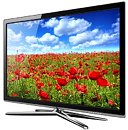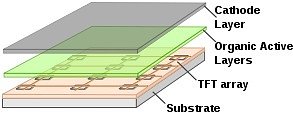Sunday, November 6th 2011
AMOLED Technology Finally Poised For The Big Time?
The current display technology standard for most PCs and TVs is LCD nowadays. However, LCD technology has significant and well known drawbacks, such as limited viewing angles, poor colours, motion blur and input lag. These problems cause some people to swear by and hold on to the old and now obsolete CRT monitors, as it had none of these problems (it did however, have lots of others). There are various types of LCD technology in mainstream use today which attempt to address these shortcomings, but none fix them all. For example, TN displays are cheap to buy, relatively fast which reduces motion smear and input lag, but at the expense of viewing angle and colour accuracy, making them suitable for fast gaming and animation. Meanwhile, IPS displays have the opposite characteristics, making them suitable for professional photographic work, where accurate colours and vibrant pictures are essential.However, AMOLED technology has the ability to fix all these problems in one go, leading to bright, crystal clear displays with wide viewing angles and excellent motion smoothness, which comes about because LEDs have extremely fast response times. But - there had to be a but - it is very expensive to produce, can be hard to view in direct sunlight and it's serviceable lifetime is relatively short, so it can't be commercialised easily for large displays such as TVs and monitors. Hence, to this date, AMOLED displays tend to be found in small gadgets, such as smartphones, where these issues are much less of a problem.
Now enter DuPont. They have wanted to bring AMOLED TVs to market for a good five years or so and they believe that they have cracked the problems. They have issued a press release stating that they are partnering with a "leading Asian manufacturer of Active Matrix Organic Light Emitting Diode (AMOLED) display products." but are mentioning no names just yet. Samsung would appear to be a leading candidate here and hopefully there will be products to show at CES 2012, given the timing of this announcement. If successful, AMOLED technology should quickly replace current LCD technology, with all its many compromises, in TVs and monitors.
There is precious little hard information about DuPont's improved manufacturing process right now, but they have produced a YouTube video here to give some idea of what's involved.
For general background information on AMOLED technology, Wikipedia has an article on it here. DuPont's website is here: www.dupont.com
DuPont's press release follows this article.
Source:
Engadget
Now enter DuPont. They have wanted to bring AMOLED TVs to market for a good five years or so and they believe that they have cracked the problems. They have issued a press release stating that they are partnering with a "leading Asian manufacturer of Active Matrix Organic Light Emitting Diode (AMOLED) display products." but are mentioning no names just yet. Samsung would appear to be a leading candidate here and hopefully there will be products to show at CES 2012, given the timing of this announcement. If successful, AMOLED technology should quickly replace current LCD technology, with all its many compromises, in TVs and monitors.
There is precious little hard information about DuPont's improved manufacturing process right now, but they have produced a YouTube video here to give some idea of what's involved.
For general background information on AMOLED technology, Wikipedia has an article on it here. DuPont's website is here: www.dupont.com
DuPont's press release follows this article.


17 Comments on AMOLED Technology Finally Poised For The Big Time?
I swear my old samsung Jet (S8000) uses an AMOLED screen
Super AMOLED is by far the best display i have ever seen in terms of view in direct sunlight considering it doesn't have AG coating
also, the way Super AMOLED is made is it lets more light through so that should save battery because it doesn't need to have high brightness to be viewable
www.youtube.com/watch?v=E_vPxDDpMWgagain, the problem has been fixed by Super AMOLED
www.oled-info.com/samsung-soon-double-their-amoleds-efficiency-lifetime-and-power-consumption
www.oled-info.com/super-amoled
www.oled-info.com/super-amoled-plus
in fact, samsung is constantling improving the AMOLED by introducing Super AMOLED PLUS and Super AMOLED HD